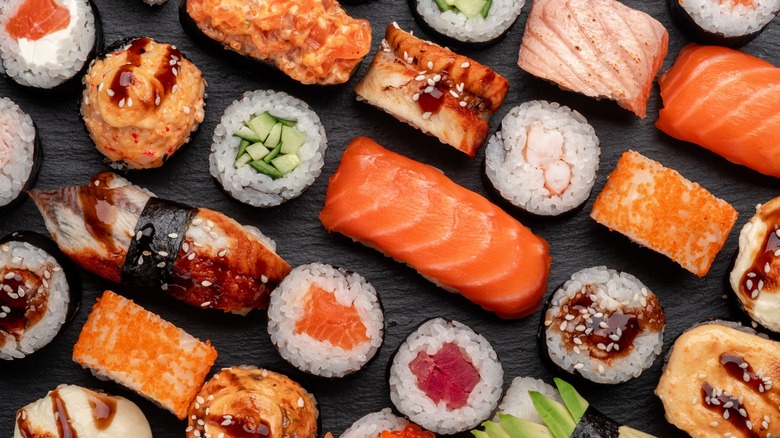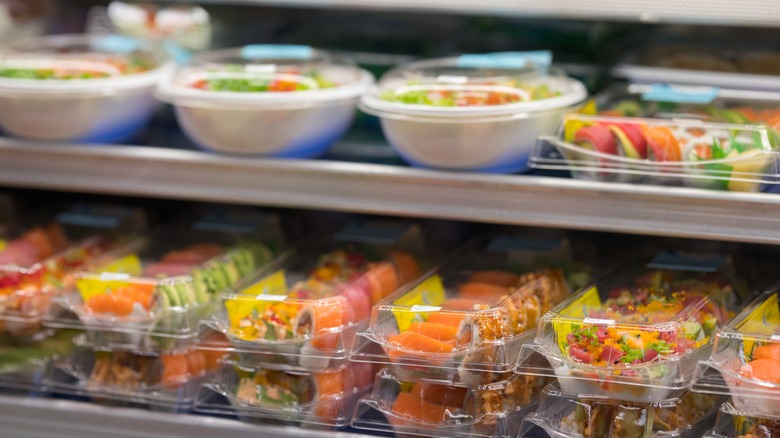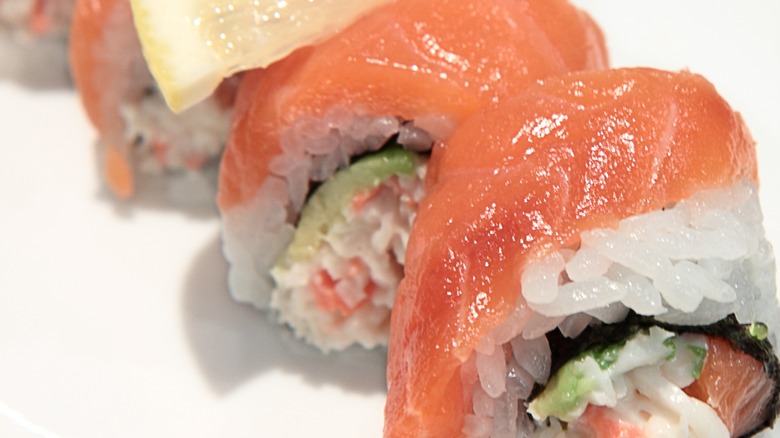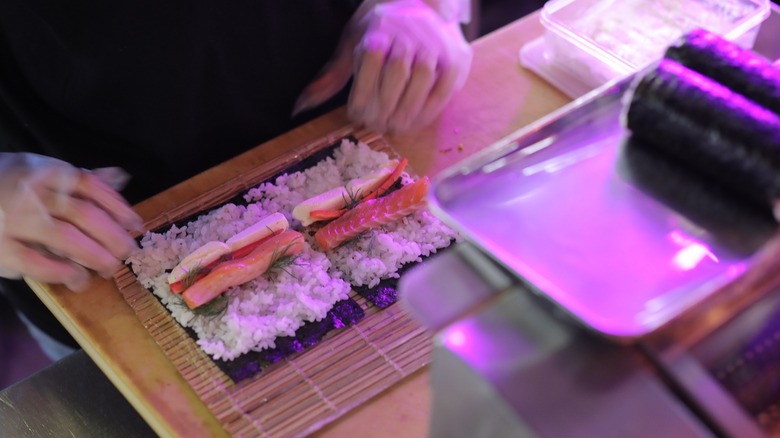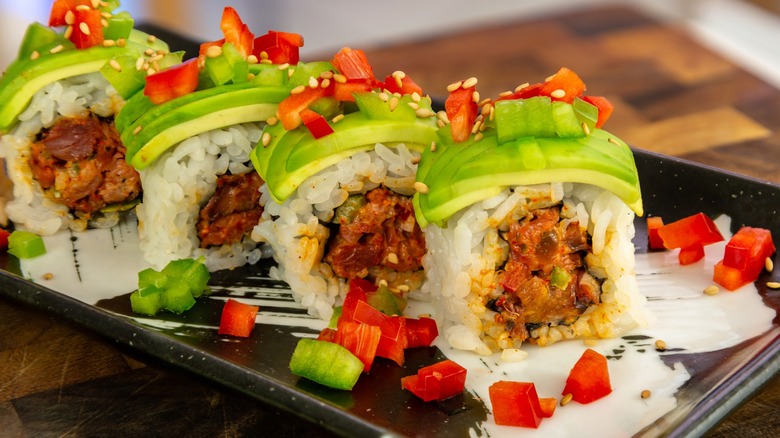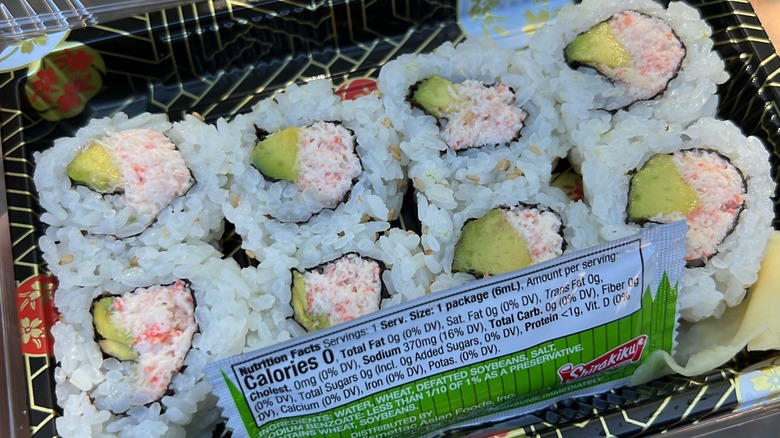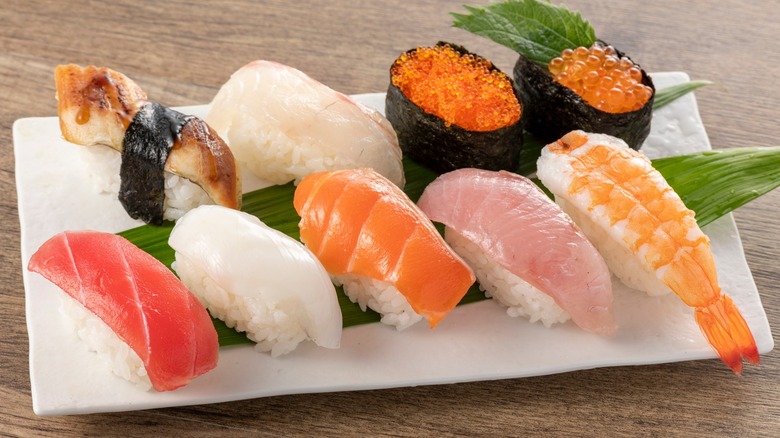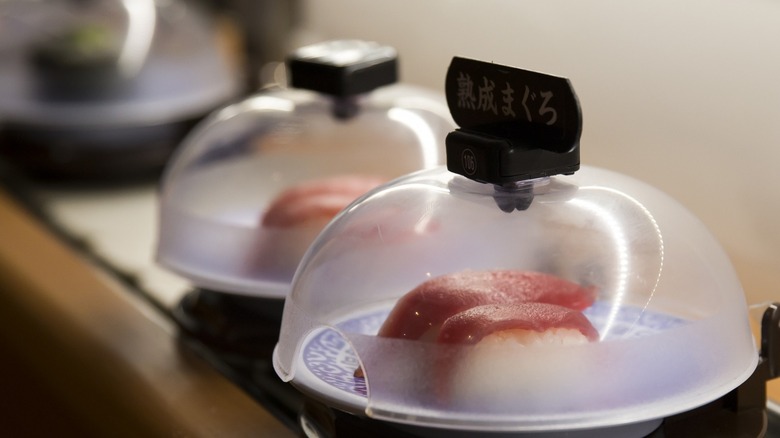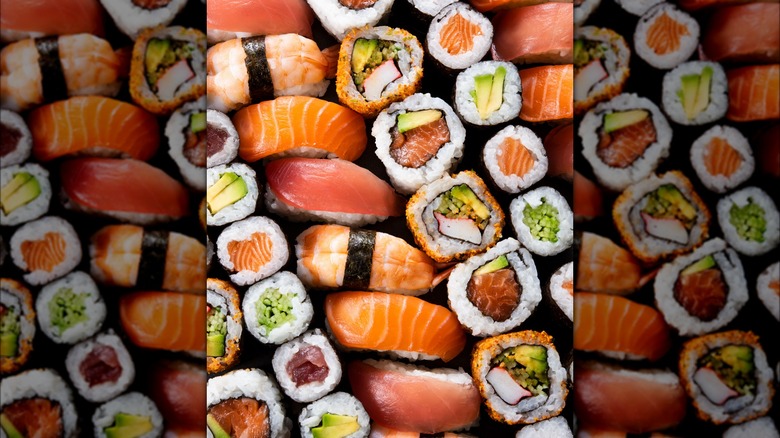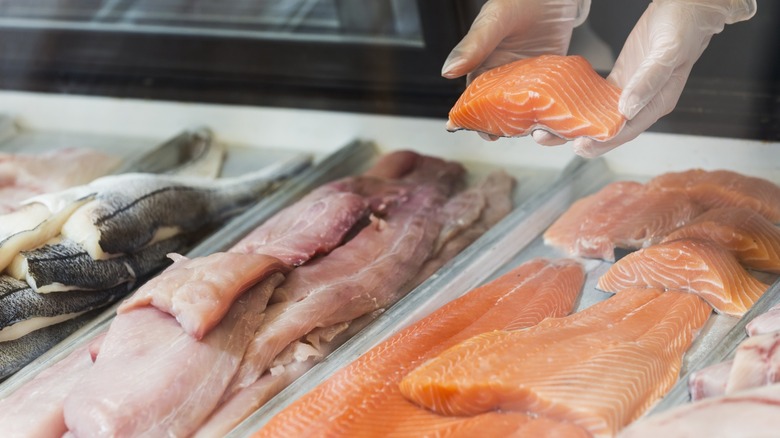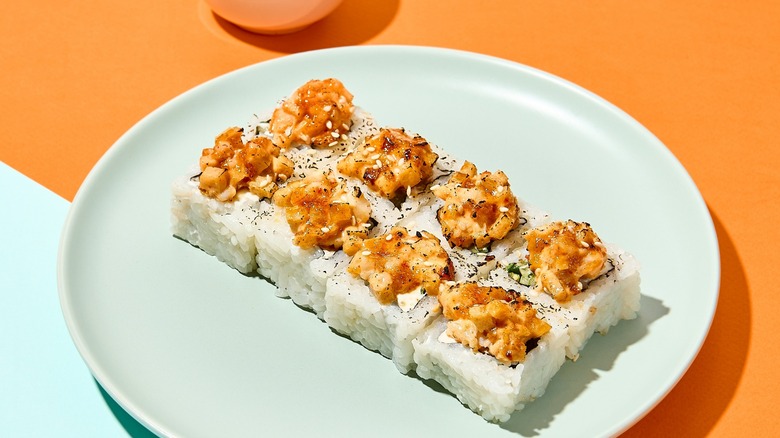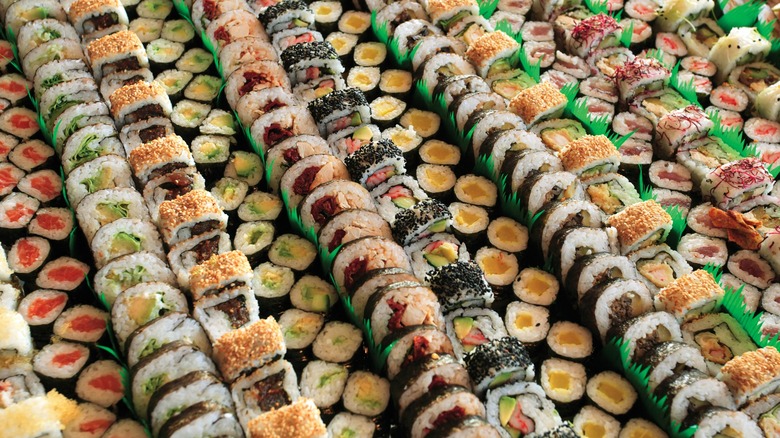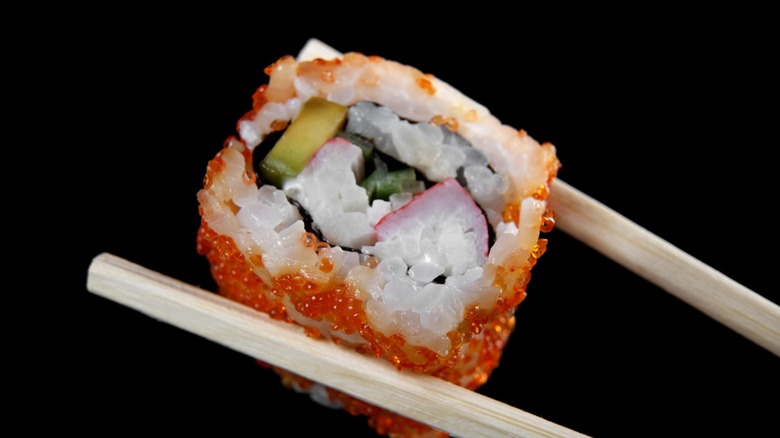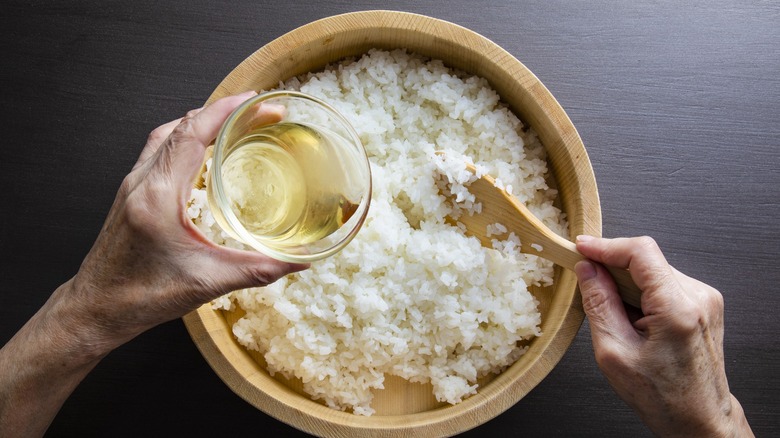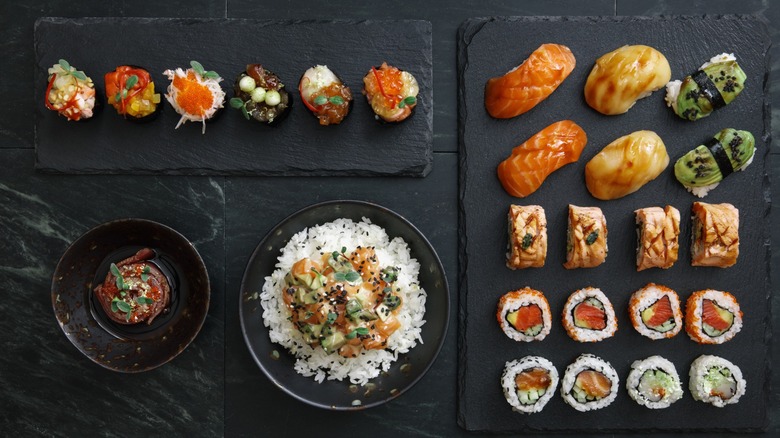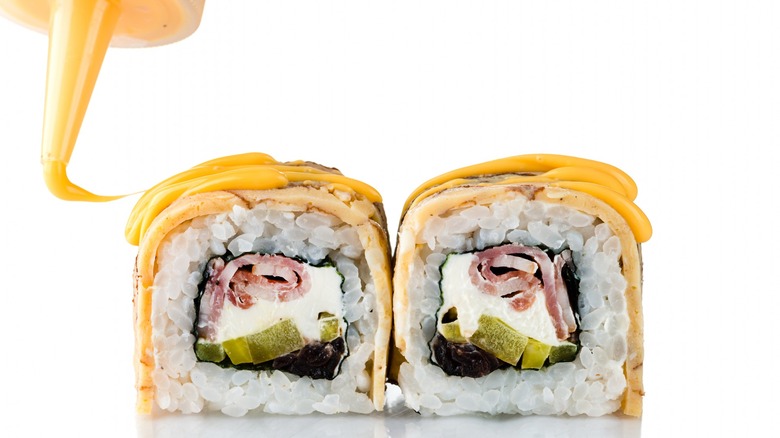16 Ways To Tell If You're Eating Cheap Sushi
While sushi was once a street food available only in Japan, today, we have the convenience of being able to buy mass-produced sushi in almost every city in the world. From high-end sushi bars where every piece of sushi is painstakingly crafted to cheap grocery store sushi designed to fuel hungry office workers, sushi is everywhere.
That also means that you'll find sushi varies in quality, depending on where you eat it. Sushi chefs train for years to perfect the art of creating delicious, visually appealing sushi. At the same time, the stuff you buy in your local grocery store is lower-quality sushi that's generally mass-produced and stored for some time before you eat it.
But how do you tell if you're eating cheap sushi or the high-quality real deal? There are some red flags: Things you can spot when buying or ordering sushi and things to look out for when visiting a sushi restaurant or take-out spot. To help you out, we've rounded up 16 ways to tell if you're eating cheap sushi.
1. It's icy cold
Picking up sushi at your local grocery store is convenient, but chances are it will be refrigerated. Sushi shouldn't be served cold; it should always be served at room temperature. Refrigerated rice can turn hard and crunchy, or the roll may crumble and fall apart.
The best sushi will always be prepared fresh, and when served, the rice should be a pleasant room temperature with a slightly sticky quality. If you're eating sushi that has been previously refrigerated, you can try removing it from the fridge about half an hour before serving it to allow it to come up to room temperature. This won't help if the rice has already turned hard, though.
Sushi is designed to be consumed immediately after it's been made. That's why sushi restaurants always prepare sushi to order, and most high-end restaurants will make your sushi in front of you. There's no refrigeration involved in the process — apart from storing the sushi-grade fish — and your sushi will never be ice cold.
2. The fish feels slimy
If you order sushi or pick up grocery store sushi and the fish is slimy, this is a huge red flag. Not only does this indicate that the sushi may be cheaply made, but it's also a sign that the sushi isn't fresh — in fact, the fish may be bad.
Fresh fish shouldn't have a strong fishy smell or feel slimy. You shouldn't eat the sushi if fish has a milky slime on it. The freshest sushi-grade fish, which is what should be used to make sushi, should only have a very faint odor and should feel moist, appearing translucent and shiny.
You may also notice that fish that feels slimy feels soft and squishy to the touch. Fresh fish should feel firm to the touch, not soft. If you eat sushi made from fish that is slimy, you could put yourself at risk of food poisoning or other illnesses, according to Healthline.
3. You don't see the sushi being made
If you're eating in a sushi bar or restaurant, you may have noticed that the chefs often prepare the sushi in front of you. Making sushi is an art form, and chefs train for years to perfect their sushi skills. Watching sushi chefs prepare sushi is all part of the culinary experience.
There's another good reason to watch sushi being prepared, too: So you know that it is fresh. Be cautious if the restaurant you're visiting doesn't prepare the sushi in front of customers. If you can't see sushi being made, it could be that it's being prepared in advance and refrigerated before serving.
Of course, this isn't always the case. Some smaller hole-in-the-wall sushi spots don't have space for an open kitchen. If you're visiting a larger sushi restaurant, this is definitely something to look out for, though, alongside other red flags.
4. The sushi rolls have lots of different ingredients
The most authentic sushi is simple. In Japan, sushi is often simply rice and fish, without complicated ingredients or lashings of sauce.
If you order sushi rolls and find they're packed with complex ingredients, the chances are that the establishment you're eating at — or have ordered from — isn't creating the best-quality sushi. Mayonnaise, sauces, and other complicated components are often used to disguise lower-quality ingredients.
Properly prepared and seasoned sushi rice and high-quality, fresh fish needs nothing else. The best sushi doesn't require a whole ton of other ingredients. That's not to say that sushi chefs can't and don't experiment, but high-quality sushi usually only contains a couple of elements rather than many different ones.
5. The restaurant smells strongly of fish
Have you ever walked into a takeout sushi spot or your neighborhood sushi restaurant and been appalled by the strong smell of fish? Whether you're eating in or taking food home, a sushi restaurant should never smell strongly of fish.
Fresh fish doesn't have a strong odor — in fact, it should barely have any odor at all. If all you can smell is an unpleasant fishy odor when walking through the door of a restaurant, that likely indicates that the restaurant is using fish that's past its prime to create cheap sushi.
Not only does this mean that the fish smells, but it may also be slimy. Eating fish that isn't fresh could be particularly dangerous when you're consuming sushi, as the fish is raw. Restaurants should only use the freshest sushi-grade fish to create sushi, so if bad fishy smells surround you, we'd recommend getting your sushi elsewhere.
6. Your sushi rolls are mostly rice
Most sushi fans have tried supermarket sushi or takeout sushi from a new place, only to be disappointed at the rice-to-filling ratio. When your sushi rolls are 90% rice and 10% filling, something is definitely up.
That could be the reason why the sushi you ordered is so affordable. Sushi rice seasoned with sugar and vinegar is the cheapest component of sushi, so if there's hardly any fresh fish, meat, or vegetables in your sushi rolls, the sushi you're consuming likely isn't of the highest quality.
As well as loads of rice, cheap sushi might be slathered in mayo or other sauces. After all, the restaurant must somehow add flavor if it's skimping on fresh ingredients in its sushi rolls.
Next time you order sushi, look to see how much rice there is in your rolls compared to other ingredients. That's one way you'll know if you're eating cheap sushi.
7. There's no Nigiri or Sashimi on the menu
Nigiri, hand-pressed sushi rice topped with a slice of fish or seafood, and sashimi, thin slices of raw fish, are two extremely popular dishes at many Japanese restaurants. Because both of these dishes are so simple, it's important that the ingredients are of the very highest quality.
For nigiri, the rice must be room temperature, perfectly seasoned, formed into the right shape by hand, and topped with fresh, sushi-grade fish that is shiny and translucent. Most sushi restaurants will include nigiri on the menu, and some will also have sashimi available.
If you don't see either of these options on the menu, this could be indicative of a cheaper sushi establishment. Because nigiri and sashimi are more expensive to make and require fresh, high-quality ingredients, smaller or cheaper sushi bars and restaurants may not include them on the menu. Nigiri and sashimi also cost more, too, and customers at more affordable spots may not be willing to pay for these dishes.
8. There's a conveyor belt
We are not trying to insult conveyor belt sushi, as some very good sushi restaurants have conveyor belts, particularly in Japan. However, common sense dictates that if sushi is made in advance and spends time revolving around a conveyor belt, it won't be as fresh as sushi made to order in front of you.
If you love the fun of choosing sushi off a conveyor belt, you are not alone. You should head to one of these restaurants for a quick, affordable sushi fix. You are unlikely to be eating expensive, high-quality sushi, though.
Not only is the sushi made in advance, but it may also have been refrigerated before making its way onto the conveyor belt. It also could have been going around the belt for a long time before anybody claimed it. The best sushi restaurants prepare sushi fresh to order in plain sight.
9. There's a huge menu
While it's true that most sushi restaurants in the U.S. will have a fairly sizable menu, you can expect most to stick to classic and popular types of sushi, with perhaps a handful of house specials. On most menus, you'll find maki, temaki hand rolls, uramaki, which are inside-out rolls, and nigiri sushi. Some restaurants may offer sashimi, and most will have at least a couple of meat and vegetarian options alongside fish.
When you visit a sushi restaurant or takeout spot with a vast menu offering hundreds of different types of sushi, beware. It's better to choose a place that does a limited number of items really well rather than a huge range of items. Chances are, an establishment like this is using cheap ingredients — and the resulting sushi may not be as high quality as you'd expect.
When it comes to sushi, look for spots offering tried and true favorites, from salmon and avocado rolls to California rolls. Generally speaking, if you don't want to end up eating cheap sushi, avoid restaurants that offer huge sushi menus — or anywhere that has more than one type of cuisine on the menu, such as sushi alongside Cantonese cuisine, for example.
10. Nobody knows where the fish came from
What's the single most important ingredient in your sushi? The fish. So if you ask your server where the fish came from and they're unable to tell you, that's a red flag.
There's an important reason why sushi-grade fish should always be used to make sushi. Sushi-grade fish — or sashimi-grade fish has been labeled as safe to eat raw. FDA guidelines state that in order to be safe to consume raw, all wild fish, except for tuna species, needs to be frozen for a specific time period at a specific temperature to eliminate parasites.
Sushi restaurants and bars will have trusted local suppliers, such as reputable fish markets. These fish markets will do their own due diligence on where fish has come from and ensure that their sushi-grade fish meets specific standards. So, you should always be able to ask where the fish in your sushi is from and get a solid answer that you're happy with.
Ultimately, if your server or anyone else at the restaurant can't tell you the origins of your fish, you're probably eating cheap sushi made with low-grade fish. That means it's likely unsafe to consume raw.
11. The rice is crumbly and/or hard
There's nothing more disappointing than getting home with your container of seemingly fresh — and expensive — takeout sushi and biting into a roll to discover the rice is hard or crumbly. Sushi that is dry and crumbles when you eat it — or that is hard and takes effort to bite into — isn't fresh.
Sushi rice should be soft and served at room temperature yet still sticky enough to hold its shape. This is particularly the case for hand-pressed sushi such as nigiri sushi.
If your sushi rolls contain hard or crumbly rice, that indicates the sushi has been made in advance and refrigerated. There's no way to know how far in advance your sushi was made.
Rice that's hard, dry, or crumbly can ruin your whole sushi experience. It's an easy-to-spot sign that you're eating cheap sushi, even if the price didn't seem cheap when you purchased it.
12. There's an all-you-can-eat deal
You don't need to pay through the nose to enjoy high-quality sushi. However, sushi isn't cheap, either. Fresh fish, nori, sushi rice, and seasonings all cost more than you might expect.
If a restaurant is offering all-you-can-eat sushi or a sushi buffet, that's usually a good sign you're eating the cheap stuff. Because sushi is so simple — often just fish, rice, and seaweed — it is quite pricey. It relies on fresh, sushi-grade fish and high-quality sushi rice.
You'll also notice that sushi served at sushi buffets can be hard, cold, or crumbly. This is because the fish and rice have either sat out for too long at room temperature or been made in advance and refrigerated for too long.
That's not to say that there are no all-you-can-eat sushi joints offering high-quality sushi. There undoubtedly are, but sadly, more often than not, you'll find these types of restaurants are serving the cheap stuff.
13. The fish looks dull
Have you ever picked up grocery store sushi only to find that the fish has a dull appearance? Whether you've chosen some salmon nigiri or spicy tuna rolls, if the fish appears dry or has discolored dark patches, it could be a sign that you're eating cheap sushi.
Fresh fish should be shiny and translucent with a vibrant color. If the fish doesn't look like this, it might mean that it isn't fresh. It might even mean that the fish is bad and the sushi is dangerous to eat.
It's not always obvious whether the fish in a sushi roll is fresh, particularly if your roll contains minced fish or seafood. However, take the time to look at your sushi rolls to see how the fish appears. If it doesn't look moist and shiny, chances are that the sushi you're dining on is cheap and low quality.
14. The rice flavor is overpowering
A key part of what makes sushi so darn tasty is the flavor of the rice. Sushi rice is subtly flavored with rice vinegar and sugar, perfectly designed to complement the fish, meat, or other fillings.
Unfortunately, cheap grocery store sushi may often be made with low-grade fish or other affordable ingredients — sometimes, these ingredients might not even be as fresh as you'd expect. To compensate for this, you'll quite often find that this cheap sushi rice is seasoned with extra vinegar and more sugar to make up for the lack of flavor of the fish or other fillings.
Some cheap sushi from grocery stores or chain sushi restaurants uses pre-mixed sushi vinegar to season the rice. This often contains fructose and other ingredients that you won't find when using a simple rice vinegar and sugar mix.
The flavor of the rice shouldn't overwhelm the other ingredients. Instead, it should complement the fresh fish and other flavors, allowing them to shine through.
15. The same sushi is available all year round
Have you ever wondered why spicy tuna rolls are often offered at your local convenience store? In high-end sushi restaurants, sushi chefs learn to work with seasonal ingredients, including fish. This means the type of sushi on the menu changes throughout the year, although this may not always be the case in smaller sushi bars.
Generally speaking, though, if you can always get the same sushi, that could indicate that the sushi served is cheap. It may even be that the fish used has been frozen if it's a type of fish that isn't common at a specific time of year.
Bear in mind that there are some sushi rolls you'll generally always find on almost every sushi restaurant menu, such as spicy tuna, salmon, avocado, and California rolls. The other, more elaborate or unusual sushi rolls may use seasonal ingredients.
16. There's a lot of mayo
A sushi roll drizzled with sriracha mayo is delicious, it's true. But did you know that if your sushi comes drenched with mayo or other sauces, it might be a sign you're eating cheap sushi?
As we mentioned earlier, high-quality sushi made by professional sushi chefs is generally pretty simple, particularly in Japan. Chefs use sushi-grade fish and subtly flavored sushi rice to create works of art. The last thing they want to do is drown all the other flavors with mayo or sauce.
If you're eating sushi that is smothered with sauce or mayo, it's likely that low-quality fish or fillings were used. The sauce is there to cover the fact the flavor of the other ingredients is lacking.
That said, there are some sushi rolls that aren't the same without a drizzle of mayo. A spicy tuna roll with a drizzle of sriracha mayo is hard to beat.
